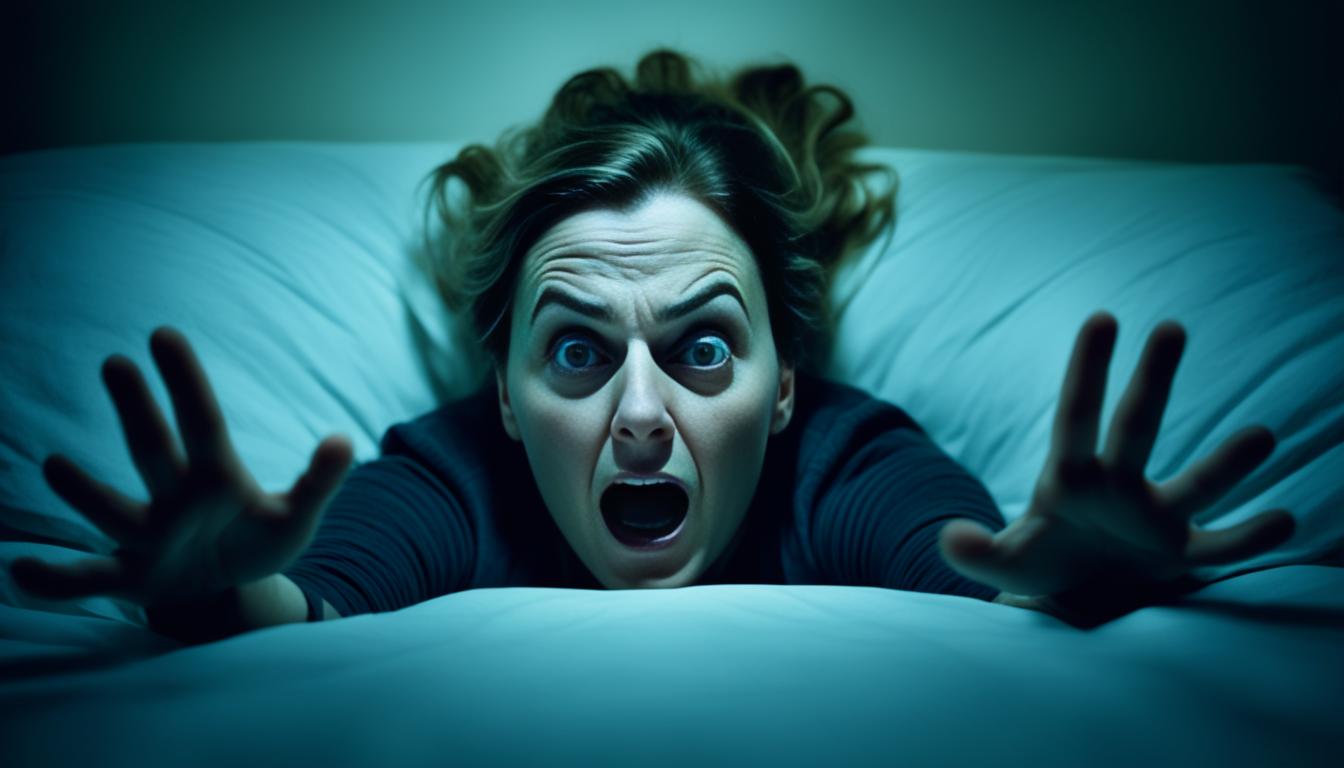Sleep terrors, also called night terrors, make people suddenly scream or cry during sleep. This happens because the body’s nervous system gets very active all of a sudden. They are part of a category called parasomnias, which are unwanted things that happen when we sleep. Night terrors happen mainly in the non-REM sleep phase, particularly in the N3 deep-sleep stage.
These scaring episodes are more likely to affect kids from 5 to 7 years old. Yet, adults can experience them too, with about 3% reporting night terrors. The cause of night terrors remains a mystery. But they could be related to lack of sleep, being too tired, stress, or changes in sleep patterns due to things like travel. Health issues such as breathing problems during sleep, restless legs, and some drugs might add to the problem.
Kids usually forget they had sleep terrors. Adults may remember some of what they dreamt. Usually, night terrors go away without needing treatment. But, you should see a doctor if they happen a lot, disturb your sleep or daily life, or if they make you very tired during the day. Doctors might suggest therapy, both to change behavior and the way you think, or in some cases, they might recommend medicine.
Key Takeaways:
- Sleep terrors, also known as night terrors, are episodes of intense fear during sleep.
- They typically occur during non-REM sleep, most commonly in children between the ages of 5 and 7.
- The exact cause of sleep terrors is still unknown, but factors such as sleep deprivation and stress may contribute to their occurrence.
- Most children do not remember the episodes, while adults may recall a small portion of their dreams.
- Treatment options for sleep terrors may include exposure therapy and cognitive-behavioral therapy.
Symptoms and Diagnosis of Sleep Terrors (Night Terrors)
Night terrors are a type of sleep issue where people wake up suddenly, feeling intense fear. It often makes them scream, cry, and their heart rate jumps. You might notice them sweating a lot, and they can move violently. Their bodies might show signs of being really worked up, like a red face, big eyes, and finding it hard to calm down.
These scary moments happen in the first part of the night and don’t last long, maybe for a few minutes. Kids usually don’t remember these events, but adults might recall a bit of a scary dream. This can be bothersome for people living with those affected by night terrors.
Doctors base the diagnosis of night terrors on how the person describes their symptoms. They look for sleep impacting anxiety that lasts more than six months. A sleep study, polysomnography, might be used to confirm the diagnosis. It checks brain activity, heart rate, and movement during sleep to show if night terrors are happening.
Sleep Terrors Symptoms:
- Loud screaming or crying
- Rapid breathing and heart rate
- Heavy perspiration
- Violent movements
- Facial flushing
- Dilated pupils
- Difficulty calming down
Facing night terrors can be really tough, potentially interfering with a good night’s rest. Getting the right diagnosis can be the first step to feeling better. Talking to a doctor is key, especially if these incidents start affecting daily life.
Next, we will explore the potential role of stem cell therapy in treating sleep terrors and other innovative treatment options available.
Stem Cell Therapy for Sleep Terrors (Night Terrors)
There is currently no specific stem cell therapy available for sleep terrors. But innovative treatments for sleep disorders are under research. This includes using stem cell therapy. While still early, stem cell therapy has shown promise in treating some neurological and sleep issues.
Stem cells might regenerate damaged tissues and boost nerve function. This could alleviate sleep terrors’ symptoms. Yet, we need more research and clinical trials to ensure stem cell therapy is both safe and effective for sleep terrors.
For now, other options like exposure therapy and cognitive-behavioral therapy can help manage sleep terrors. They may also improve how well you sleep. If you have sleep terrors, it’s best to talk to a doctor who’s familiar with these issues. They can help you find the right treatment for you.
FAQ
Q: What are sleep terrors?
A: Sleep terrors, or night terrors, are times when people feel scared during sleep. This fear can make them suddenly cry out or scream. Their body may also show signs of fear, like fast heartbeats.
Q: Who is most likely to experience sleep terrors?
A: Children often have sleep terrors, especially between 5 and 7 years old. Yet, adults can have them too. About 3% of adults face sleep terrors.
Q: What causes sleep terrors?
A: The reason behind sleep terrors is not fully clear. But, experts think they can be linked to not getting enough sleep, or feeling very tired. Stress and changes in sleep routines can also play a part. So can fever.
Q: How are sleep terrors diagnosed?
A: Doctors look at how the problem is showing up and what the person says about how they feel. For a diagnosis, sleep terrors must cause poor sleep, anxiety, and be disruptive for over six months. Tests like polysomnography can help check if it’s really just sleep terrors.
Q: Is there a specific stem cell therapy for sleep terrors?
A: Right now, there’s no set stem cell therapy for sleep terrors. But, scientists are looking into new ways, including stem cell therapy, to treat sleep issues and similar problems. They hope to find more ways to help in the future.
Q: How effective are exposure therapy and cognitive-behavioral therapy in managing sleep terrors?
A: Practices like exposure therapy and cognitive-behavioral therapy can help with sleep terrors. They aim to make sleep better and handle the fear. It’s best to talk to a specialist who knows how to deal with these issues to find what’s best for you.

